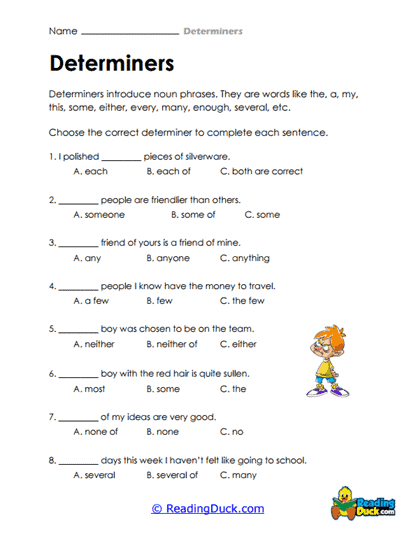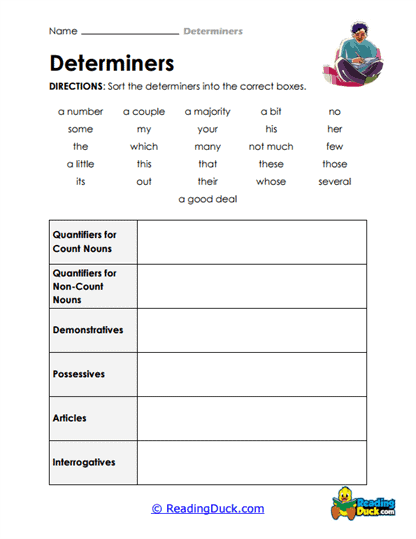Determiners Worksheets
About Our Determiners Worksheets
Our Determiners Worksheets collection is a comprehensive resource designed to help students develop a clear understanding of determiners, an essential part of English grammar. Falling under the Grammar category within the broader Skills section, these worksheets focus on building students' ability to recognize, use, and apply determiners in sentences effectively. Determiners are crucial for adding specificity, quantity, and clarity to nouns, making them a fundamental aspect of grammatical proficiency.
This collection offers a wide range of activities that guide learners through the different types of determiners, including articles, demonstratives, possessives, quantifiers, and numbers. These worksheets gradually increase in difficulty, allowing students to build their understanding step-by-step. With each worksheet, students refine their ability to use determiners in both written and spoken English. The worksheets are available in PDF format, making them easy to view, download, and print for classroom or home use. Additionally, each worksheet includes a downloadable answer key to ensure that students and educators can easily track progress and correct mistakes.
What Are Determiners? A Comprehensive Exploration
Determiners play a vital role in grammar by providing context to nouns. They precede nouns and help specify whether a noun is something definite or indefinite, singular or plural, or something that belongs to someone. Without determiners, our sentences would be vague and unclear, lacking the precision that makes communication effective.
Definition of Determiners:
Determiners are words placed before nouns to indicate quantity, possession, definiteness, or to identify a noun. They help clarify which noun is being referred to, how many or how much of something there is, and who owns something. Determiners are essential in every sentence that includes a noun because they provide specificity.
Types of Determiners:
1. Articles:
-
- Articles are perhaps the most common type of determiner and come in two forms: definite and indefinite.
The is the definite article, used to refer to something specific.
Example: "Please pass the salt." (The refers to a specific item.)
A and an are indefinite articles, used when referring to something non-specific.
Example: "I want to read a book." (A indicates any book, not a particular one.)
2. Demonstratives:
-
- Demonstrative determiners point out specific things based on their proximity to the speaker.
This and these indicate something close to the speaker.
Example: "This cake is delicious."
That and those refer to things farther away.
Example: "Those books are on the top shelf."
3. Possessive Determiners:
-
- These determiners show ownership or possession.
Common possessive determiners include my, your, his, her, its, our, their.
Example: "Her backpack is blue."
Possessive determiners help distinguish who the noun belongs to, adding clarity to the sentence.
4. Quantifiers:
-
- Quantifiers indicate how much or how many of something exists. They can refer to specific or non-specific quantities.
Some examples include some, many, few, several, each, every, all.
Example: "Many students enjoy reading."
Quantifiers give the reader or listener a sense of the quantity being discussed.
5. Numbers:
-
- Numbers are also considered determiners when they come before a noun to indicate a specific quantity.
Example: "There are two apples in the basket."
Numbers provide an exact amount, adding precision to the noun.
Why Determiners Matter:
Determiners are essential because they provide context and clarity to sentences. They help to distinguish between specific and general items, indicate who owns what, and express quantities accurately. Without them, communication would be ambiguous and less effective. By understanding how to use determiners correctly, students can significantly enhance both their writing and speaking skills.
Techniques for Introducing Determiners to Students
When teaching determiners, it’s essential to present the concept in a way that is engaging and accessible to students. Since determiners are fundamental to building sentences, educators can use several effective techniques to help students understand and apply them confidently.
- Start with Simple Examples: Begin by introducing determiners students encounter frequently in everyday language, such as a, an, and the. This gives students a foundation to build on before moving on to more complex determiners like quantifiers and possessives.
- Example: Present a sentence like "I see a cat" and "I see the cat" to highlight the difference between indefinite and definite articles.
- Use Visual Aids: Visual aids, such as charts that categorize the different types of determiners, help students grasp the concept visually. Create a chart that separates articles, demonstratives, possessives, and quantifiers, with examples of each type. This allows students to see how each type of determiner functions within a sentence.
- Contextual Sentences: Provide students with sentences that lack determiners and ask them to fill in the blanks. This activity forces students to think about which determiner makes sense in a given context, reinforcing their understanding of how determiners clarify meaning.
- Example: "____ apple is on the table." (Possible answers: This, That, The, An, depending on the context.)
- Compare and Contrast: Help students see the difference between various determiners by presenting contrasting sentences. For example, show how changing a determiner can change the meaning of a sentence.
- Example: "I have few books" versus "I have many books." This activity encourages students to think critically about the impact of determiners.
By using these techniques, educators can ensure that students develop a clear understanding of how determiners function in everyday communication.
Addressing Common Challenges in Learning Determiners
Although determiners may seem simple, students often face certain challenges when learning to use them correctly. These challenges usually stem from confusion over the different types of determiners and how they relate to nouns.
- Challenge: Confusing Definite and Indefinite Articles:
- Students sometimes struggle to decide when to use a/an versus the, especially if English is not their first language.
- Strategy: Provide students with real-life examples and practice exercises that show how a/an are used for non-specific items and the for specific ones. Have students work with pairs of sentences to demonstrate the difference, such as "I saw a dog" versus "I saw the dog."
- Challenge: Misusing Quantifiers:
- Some students may misuse quantifiers like many and much or few and little, often confusing countable and uncountable nouns.
- Strategy: Create exercises that focus specifically on the distinction between countable and uncountable nouns, such as "I have many apples" versus "I have much water." Ensure that students understand which quantifiers match which type of noun.
- Challenge: Overlooking Possessive Determiners:
- Students may forget to use possessive determiners, especially when speaking or writing quickly.
- Strategy: Reinforce the use of possessive determiners by practicing sentences where ownership is critical to the meaning. Encourage students to use them when describing objects or actions in personal writing exercises, such as "This is my pencil" or "That is her car."
By addressing these common challenges through targeted strategies, students can overcome their initial difficulties and gain confidence in their use of determiners.
Engaging Activities to Reinforce Determiner Skills
To ensure that students fully grasp the concept of determiners, educators can introduce a variety of supplementary activities. These activities are suitable for both classroom and homeschool settings, offering flexibility while reinforcing learning in a fun, interactive way.
- Determiner Sorting Game (Grades 2-4): Create a sorting game where students are given cards with different determiners on them and must match them with appropriate nouns. For example, they could match this with "pencil" or many with "books." This activity reinforces the connection between determiners and the nouns they modify.
- Fill-in-the-Blank Stories (Grades 3-5): Give students short stories with missing determiners and ask them to fill in the blanks. This allows students to practice applying the correct determiner in context while also encouraging creativity.
- Example: "____ boy went to the store to buy ____ apples." Students could fill in The and some or A and a few depending on the context they create.
- Determiner Bingo (Grades 3-6): Create a Bingo game where the squares contain different types of determiners. As you call out nouns, students must match them with an appropriate determiner on their card. This game adds an element of competition while reinforcing the various determiner categories.
- Story Writing with Determiners (Grades 4-6): Have students write short stories using a specific number of determiners from each category (articles, possessives, demonstratives, etc.). This activity encourages them to apply what they’ve learned in a creative context and demonstrates their ability to use determiners in longer writing.
The Importance of Mastering Determiners in Language
Learning how to use determiners correctly is essential for effective communication. Determiners give sentences clarity, specificity, and meaning, allowing speakers and writers to express their ideas precisely. Whether indicating quantity, possession, or definiteness, determiners play a vital role in ensuring that the reader or listener understands the message.
Mastering determiners not only improves students' grammar skills but also enhances their ability to communicate effectively in both academic and everyday settings. As students progress in their language studies, their understanding of determiners will help them construct more complex and accurate sentences, ensuring clarity and precision in their writing and speaking.









